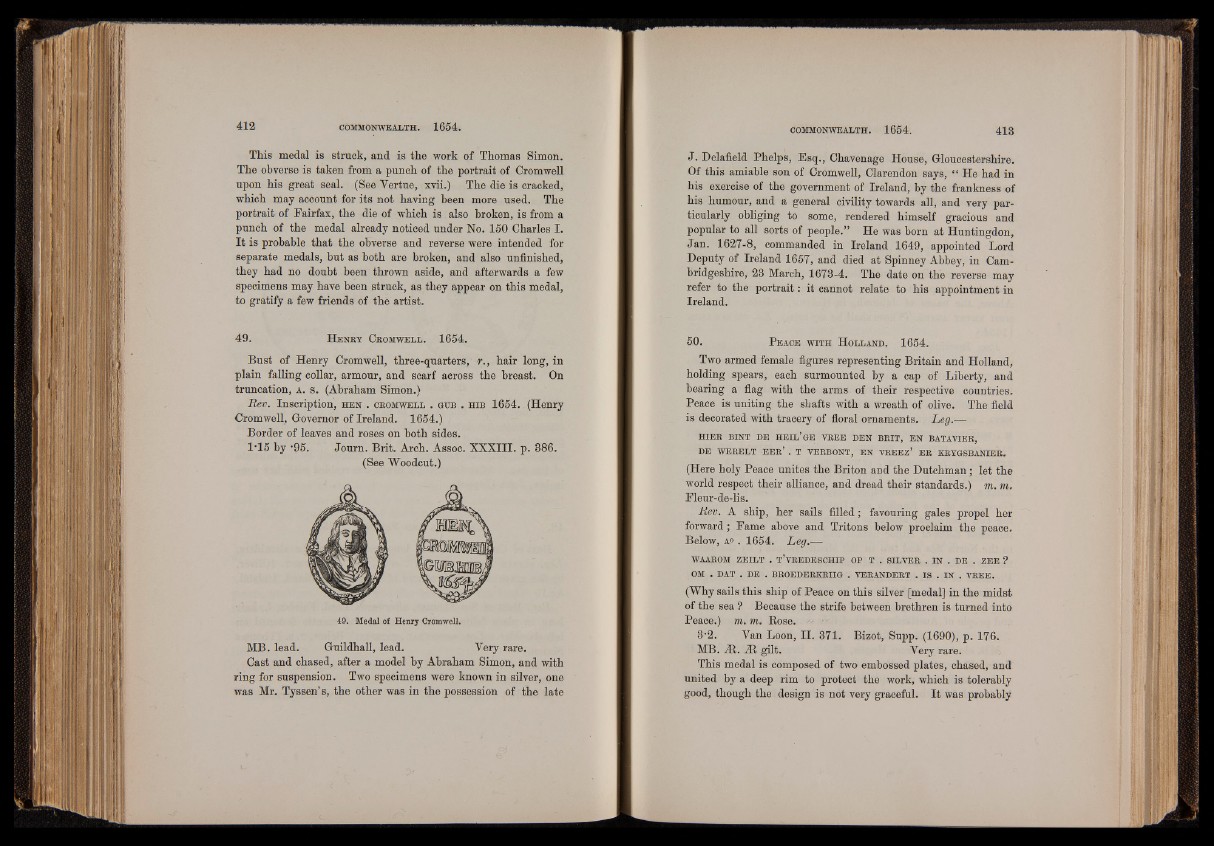
This medal is struck, and is the work of Thomas Simon.
The obverse is taken from a punch of the portrait of Cromwell
upon his great seal. (See Vertue, xvii.) The die is cracked,
which may account for its not having been more used. The
portrait of Fairfax, the die of which is also broken, is from a
punch of the medal already noticed under No. 150 Charles I.
I t is probable that the ohverse and reverse were intended for
separate medals, but as both are broken, and also unfinished,
they had no doubt been thrown aside, and afterwards a few
specimens may have been struck, as they appear on this medal,
to gratify a few friends of the artist.
49. H e n b y Cb o m w e l l . 1654.
Bust of Henry Cromwell, three-quarters, r., hair long, in
plain falling collar, armour, and scarf across the breast. On
truncation, a . s . (Abraham Simon.)
Rev. Inscription, h e n . c bom w e l l . g u b . h ib 1654. (Henry
Cromwell, Governor of Ireland. 1654.)
Border of leaves and roses on both sides.
1-15 by '95. Journ. Brit. Arch. Assoc. XXXIII. p. 386.
(See Woodcut.)
kwwm
49. Medal of Henry Cromwell.
MB. lead. Guildhall, lead. Yery rare.
Cast and chased, after a model by Abraham Simon, and with
ring for suspension. Two specimens were known in silver, one
was Mr. Tyssen’s, the other was in the possession of the late
J. Delafield Phelps, Esq., Chavenage House, Gloucestershire.
Of this amiable son of Cromwell, Clarendon says, “ He had in
his exercise of the government of Ireland, by the frankness of
his humour, and a general civility towards all, and very particularly
obliging to some, rendered himself gracious and
popular to all sorts of people.” He was born at Huntingdon,
Jan. 1627-8, commanded in Ireland 1649, appointed Lord
Deputy of Ireland 1657, and died at Spinney Abbey, in Cambridgeshire,
28 March, 1673-4. The date on the reverse may
refer to the portrait: it cannot relate to his appointment in
Ireland.
50. P ea c e w it h H o l la n d . 1654.
Two armed female figures representing Britain and Holland,
holding spears, each surmounted by a cap of Liberty, and
bearing a flag with the arms of their respective countries.
Peace is uniting the shafts with a wreath of olive. The field
is decorated with tracery of floral ornaments. Leg.—
HIEE BINT DE HEIL’gE VBEE DEN BEIT, EN BATAVIEE,
DE WEEELT EEB’ . T VEEBONT, EN VBEEz’ E E KBYGSBANIEB.
(Here holy Peace unites the Briton and the Dutchman; let the
world respect their alliance, and dread their standards.) m. m.
Fleur-de-lis.
Rev. A ship, her sails filled; favouring gales propel her
forward; Fame above and Tritons below proclaim the peace.
Below, a° . 1654. Leg.—
WAAEOM ZEILT . T’vEEDESCHIP OP T . SILVEE . IN . DE . ZEE ?
OM . DAT . DE . BBOEDEEKRIIG . VEBANDEET . IS . IN . VEEE.
(Why sails this ship of Peace on this silver [medal] in the midst
of the sea ? Because the strife between brethren is turned into
Peace.) m. m. Rose. •
8’2. Yan Loon, II. 371. Bizot, Supp. (1690), p. 176.
MB. At. At gilt. Yery rare.
This medal is composed of two embossed plates, chased, and
united by a deep rim to protect the work, which is tolerably
good, though the design is not very graceful. It was probably